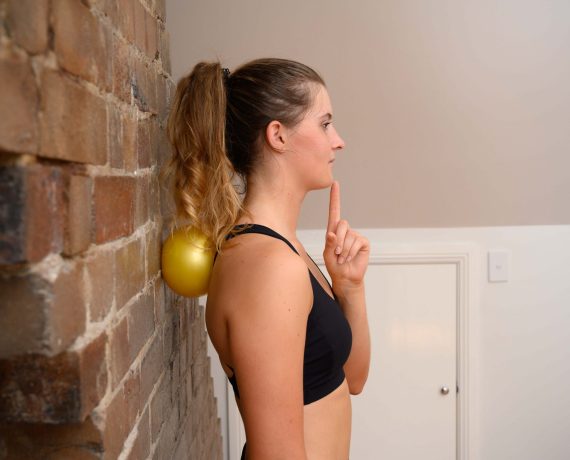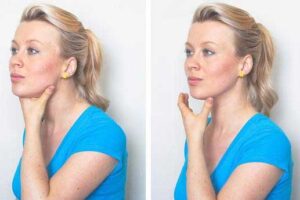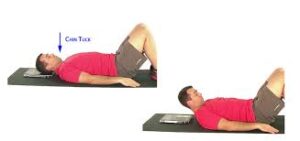

If you are seeking an answer to “how to fix forward head posture fast with chin tucks” then, this article by bestforwardheadposturefix.com shall try and address this issues in its complete entirety.
Chin tucks is perhaps the most popular and the most widely used exercise both “in and out” of the gym for treating the side effects of a bad neck posture.
I believe, many articles and even scientific studies may already be present on this exercise form (on the World Wide Web) yet, I would try and cover those aspects that may have been left behind by others.
So, here goes:
How to Fix Forward Head Posture with Chin Tucks: Article Index:
1) What are Chin Tucks?
- The Lowdown on Chin Tucks
- The Perks of Chin Tucks
2) How are Chin Tucks Good for Fixing Forward Head Posture?
- How Chin Tucks Help Correct Forward Head Posture?
- Reducing Neck Pain
- Enhancing Postural Awareness
- Conclusion: A Simple Yet Effective Solution
3) How I Perform Chin Tucks to Fix My Text Neck?
- Step 1: Align Your Posture
- Step 2: The Tuck
- Step 3: Hold and Release
- Why It Works?
4) How Often Should I Perform this Exercise to My Fix Mom’s Shoulders?
- Daily Reps: The Sweet Spot
- Why Daily Practice Works?
- Keep an Eye on Progress
5) FAQs on Fixing Forward Head Posture Vis Chin Tucks
6) Takeaway
What are Chin Tucks?
Let’s talk chin tucks.
No, it is not a new dance move or a trendy skincare hack, but trust me, it is just as essential—especially if you spend hours hunched over a screen.
The Lowdown on Chin Tucks
Imagine this: you’re at your desk, shoulders slumped, head jutting forward like you’re trying to see into the future.
Sound familiar?
That, my friend, is what we call the dreaded “tech neck.” Enter the chin tuck—a small but mighty exercise designed to bring your head back to where it belongs, right in line with your spine.
A chin tuck is like a reset button for your neck.
It’s all about activating those unsung heroes in your neck, the deep cervical flexors.
These muscles are often forgotten, but they’re crucial for maintaining good posture and keeping neck pain at bay.
Think of them as the core muscles for your neck, providing stability and balance every time you pull your head back.
The Perks of Chin Tucks
Now, you might be wondering, “Why should I care about this chin tuck business?”
Well, the benefits are bigger than they seem. By practicing chin tucks regularly, you’re not just doing a favor for your neck; you are also helping out your entire spine.
When your head is properly aligned, the rest of your spine follows suit, reducing strain and making you stand taller and more confidently.
Plus, let’s be real—nobody wants to develop a permanent forward head posture.
Chin tucks are like your secret weapon against becoming the poster child for bad posture. This is quite similar to cobra pose in yoga.
So, even if they feel a little funny at first, give your neck some TLC with these small but effective movements.
Your future self (and spine) will be forever grateful!
How are Chin Tucks Good for Fixing Forward Head Posture?
Forward Head Posture (FHP) is more than just a slouch; it is a condition where the head juts forward from its ideal alignment with the spine, placing undue stress on the neck and upper back muscles.
This posture is increasingly common, especially among those who spend hours in front of computers or on mobile devices using incorrect screen position.
How Chin Tucks Help Correct Forward Head Posture?
Chin tucks are a simple yet effective exercise to counteract FHP by strengthening the deep cervical flexors, the muscles located at the front of your neck.
These muscles play a crucial role in maintaining the proper alignment of the head and neck.
Scientific Backing: Strengthening Deep Cervical Flexors
Studies have shown that weak deep cervical flexors are a primary contributor to FHP.
A study published in the journal Spine found that targeted exercises, like chin tucks, significantly improved the activation and strength of these muscles, leading to better head and neck alignment.
Reducing Neck Pain
FHP is often associated with chronic neck pain due to the extra load it places on the cervical spine.
Chin tucks help by realigning the head with the spine, thereby reducing the strain on the neck muscles.
A 2014 study in the Journal of Physical Therapy Science demonstrated that performing chin tuck exercises decreased neck pain in participants with FHP by improving the posture of the cervical spine.
Enhancing Postural Awareness
Chin tucks also promote better postural awareness.
By practicing this exercise, individuals become more conscious of their head and neck positioning throughout the day, leading to more natural, long-term correction of FHP.
A 2017 study in the Journal of Bodywork and Movement Therapies found that regular chin tuck exercises not only improved posture but also helped maintain these improvements over time.
Conclusion: A Simple Yet Effective Solution
Chin tucks are a scientifically-backed, easy-to-do exercise that targets the root cause of Forward Head Posture.
By regularly incorporating chin tucks into your routine, you can strengthen the deep cervical flexors, reduce neck pain, and achieve better overall posture.
>>> Want to Learn My “Secret Method” to “Fix Forward Head Posture” at Home??? Click Here to Find Out! <<<
How I Perform Chin Tucks to Fix My Text Neck?
If you are anything like me, you have probably spent a good chunk of your day hunched over your phone or laptop, lost in the digital world.
This modern-day posture problem, affectionately known as “text neck,” is more than just a temporary discomfort.
It is a posture issue that can lead to long-term neck pain, stiffness, and even tension headaches.
To combat this, I’ve found chin tucks to be a game-changer.
My Approach to Chin Tucks:
Let’s get into the nitty-gritty of how I perform chin tucks to keep text neck at bay.
The beauty of this exercise is its simplicity—you can do it anywhere, anytime, without any special equipment.
Step 1: Align Your Posture
First, I make sure I’m sitting or standing tall. Think of aligning your ears with your shoulders, like you’re being pulled upward by an invisible string.
This initial posture check is crucial because chin tucks are all about reinforcing proper alignment.
Step 2: The Tuck
Next, I gently draw my chin backward, as if I’m trying to create a double chin (not exactly glamorous, but it works!).
The key is to keep the movement small and controlled. I focus on pulling my chin straight back, not down, to avoid any unnecessary strain on my neck.
Step 3: Hold and Release
Once my chin is tucked, I hold the position for 5 to 10 seconds.
I can feel the muscles at the front of my neck (the deep cervical flexors damaged by forward neck) working hard to keep everything in place.
Then, I slowly release the tuck and repeat the process 10-15 times.
Why It Works?
Chin tucks help me by strengthening those underused neck muscles, counteracting the forward head posture that comes with text neck.
The more I do them, the easier it becomes to maintain good posture throughout the day, even when I’m glued to my screen.
How Often Should I Perform this Exercise to My Fix Mom’s Shoulders?
If you have noticed your head creeping forward like you’re constantly peering into the future, you might be dealing with forward head posture.
Don’t worry, though—chin tucks are here to save the day! But the big question is: how often should you be doing them?
Daily Reps: The Sweet Spot
For the best results, aim to perform chin tucks daily. Yes, you read that right—every single day. Doing 2-3 sets of 10-15 repetitions each day is ideal.
Chin tucks are a gentle exercise, so they would not strain your neck muscles or require long recovery periods. The daily routine helps your body gradually adjust, reinforcing the correct head and neck alignment over time.
Why Daily Practice Works?
Forward head posture is often the result of years of bad habits, like slouching at a desk or constantly looking down at your phone.
To counteract this, you need consistent practice to retrain your muscles.
A study published in the Journal of Physical Therapy Science found that regular chin tuck exercises significantly improved the alignment of the cervical spine.
This means that by doing chin tucks daily, you are steadily reversing the bad habits that led to your forward head posture in the first place.
Keep an Eye on Progress
While daily chin tucks are beneficial, it is important to listen to your body.
If you start to feel any discomfort, it is okay to scale back a bit. Maybe try doing them every other day until your muscles adapt.
However, if you are noticing improvements in your posture and less tension in your neck, keep up the daily routine—it is a sign you’re on the right track!
In summary, making chin tucks a daily habit is a simple and effective way to tackle forward head posture. Stick with it, and you’ll be holding your head high (literally) in no time!
FAQs on Fixing Forward Head Posture Vis Chin Tucks
Q1: How do chin tucks help in correcting forward head posture?
A1: Chin tucks strengthen the deep neck flexor muscles, which are crucial for maintaining proper head alignment. By regularly performing chin tucks, you can counteract the muscle imbalances that contribute to forward head posture.
Q2: What is the correct technique for performing chin tucks?
A2: To perform chin tucks:
- Sit or stand upright with your back straight and shoulders relaxed.
- Gently draw your chin straight back, as if making a double chin, without tilting your head up or down.
- Hold the position for 5 seconds, then relax.
- Repeat 10–15 times, aiming for 2–3 sets daily.
Q3: How often should chin tucks be performed to see improvements in forward head posture?
A3: Incorporating chin tucks into your daily routine, performing 10–15 repetitions per set and aiming for 2–3 sets throughout the day, can lead to noticeable improvements over time. Consistency is key to effectively correcting forward head posture.
Q4: Are there any precautions to consider when doing chin tucks for forward head posture?
A4: While chin tucks are generally safe, it’s important to perform them gently to avoid overstretching. If you experience pain or discomfort, stop the exercise and consult a healthcare professional. Avoid tilting your head up or down during the movement to ensure proper technique.
Q5: Can chin tucks be combined with other exercises to enhance the correction of forward head posture?
A5: Yes, combining chin tucks with exercises that strengthen the upper back and shoulders, such as shoulder blade squeezes and chest stretches, can provide a more comprehensive approach to correcting forward head posture. Additionally, incorporating regular breaks and maintaining ergonomic work environments can further support posture correction.
Takeaway
I personally find chin-tucks to be the easiest and one of the most effective ways to treat bad neck posture.
While it does take some effort on your part (mostly mental effort) to indulge in this exercise, once you get in the rhythm, your cervical spine shall thank you for your efforts.
I would also like to state that this exercise form is perhaps the most widely accepted and performed the world over (for fixing nerd neck).
So, if you want to fix your forward head posture fast then, do not forget to follow this exercise on a regular basis.
References:


